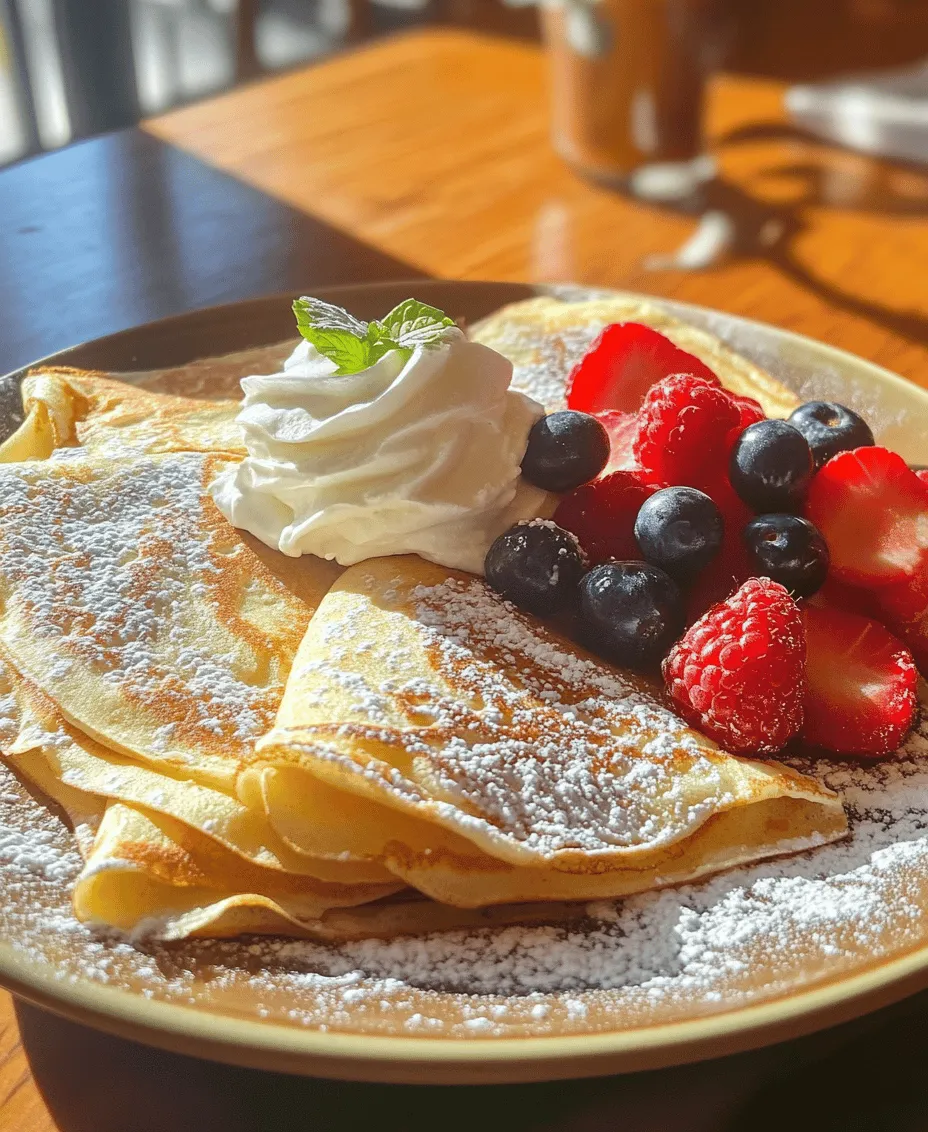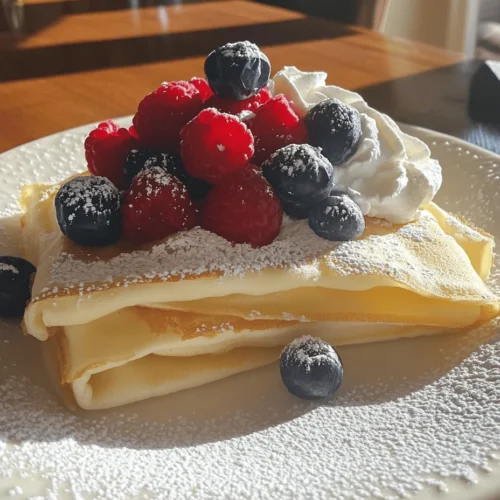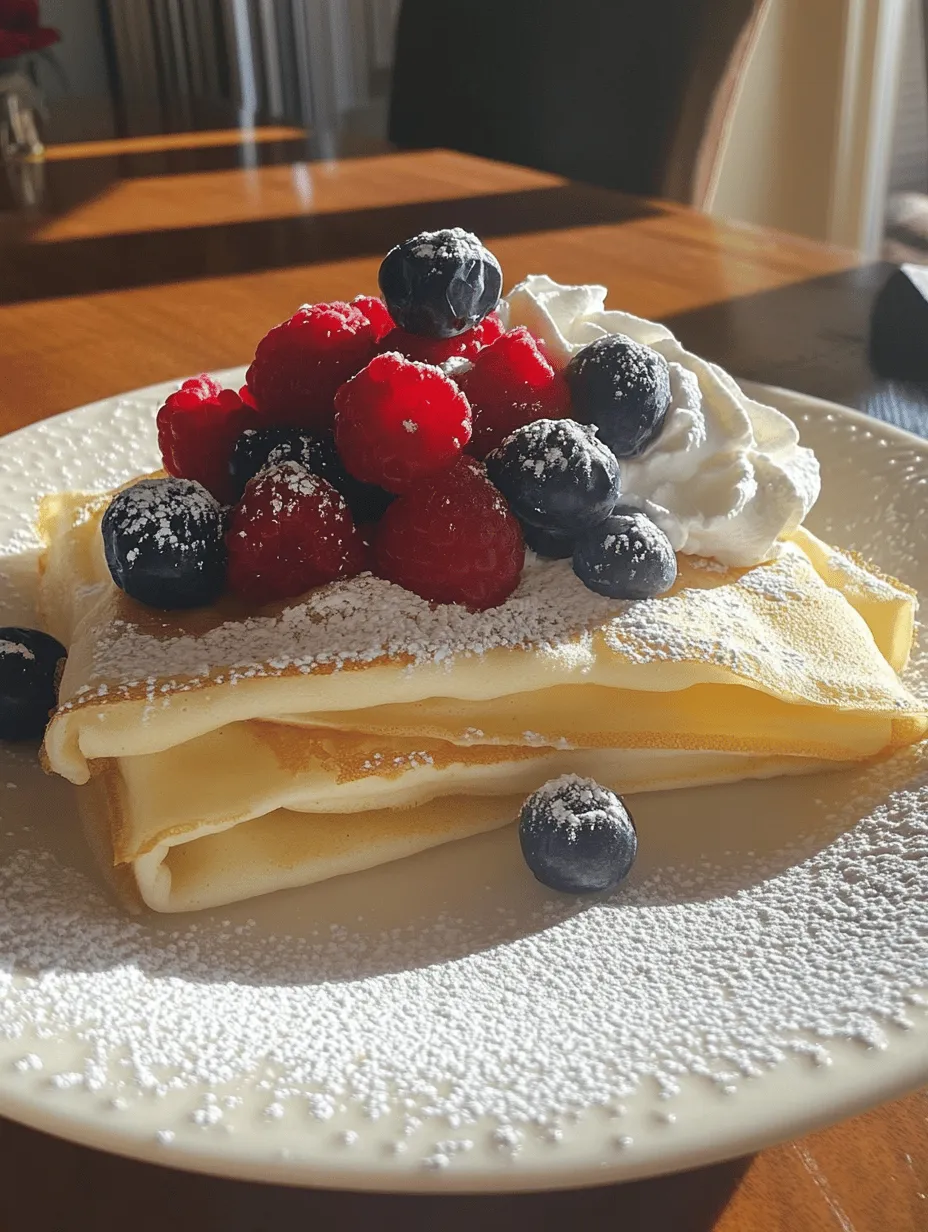Introduction to Delightful Vanilla Crepes
Crepes are one of those extraordinary dishes that can effortlessly transition from breakfast to dessert, and even serve as a delightful snack. Originating from France, these thin, delicate pancakes have gained global popularity, making them a staple in various cuisines. Their versatility is unmatched; whether filled with sweet ingredients like fruits and whipped cream or savory options like ham and cheese, crepes can satisfy any palate. Today, we’ll dive into the world of delightful vanilla crepes, a sweet variation that can be enjoyed at any time of the day.
Vanilla crepes are particularly appealing because they embody a comforting simplicity. The aromatic notes of vanilla, combined with a soft, tender texture, make these crepes a perfect canvas for a wide array of toppings. Imagine waking up to a plate of warm, fluffy crepes drizzled with maple syrup, topped with fresh berries, or perhaps even a dollop of whipped cream. The joy of making these at home lies not only in the delicious results but also in the ability to customize them to your liking. From a sprinkle of powdered sugar to a generous scoop of ice cream, the choice is yours.
As we venture further into the recipe, we’ll uncover the key ingredients that make up these delightful vanilla crepes, as well as the simple steps to prepare them. Prepare to impress your family and friends with this cherished recipe!
Understanding Crepes: A Culinary Delight
Crepes are defined as thin pancakes that are made from a simple batter of flour, eggs, and liquid, which can be cooked quickly on a hot surface. There are two main types of crepes: sweet and savory. Sweet crepes, like our vanilla crepes, are typically enjoyed with sweet fillings and toppings, while savory crepes, known as galettes, are often filled with ingredients like cheese, vegetables, or meats.
The origin of crepes can be traced back to Brittany, a region in northwest France, where they were traditionally made from buckwheat flour. Over time, they evolved into the more commonly known version made with all-purpose flour, which is lighter and allows for a more delicate texture. In French culture, crepes hold a significant place, often enjoyed during celebrations like La Chandeleur (Crepe Day) on February 2nd, when families gather to flip crepes and make wishes for the year ahead.
Crepes are not limited to French cuisine, however. In Japan, for example, the popular “crepe” is often a sweet dessert served in a cone shape, filled with fruits, whipped cream, and even ice cream. The global adaptation of crepes showcases their culinary versatility and their ability to bring people together over a shared love for delicious food.
Key Ingredients for Vanilla Crepes
To create the perfect vanilla crepes, it’s essential to understand the role of each ingredient in the batter. Here’s a brief overview of the key components:
All-Purpose Flour
All-purpose flour is the backbone of the crepe batter, providing the necessary structure. It helps to create the thin, yet sturdy texture that allows the crepes to hold their shape once cooked. When measuring flour, it’s essential to spoon it lightly into the measuring cup and level it off to avoid using too much, which can result in dense crepes.
Eggs
Eggs serve as a binding agent in the batter, adding richness and moisture. They also help to create a tender texture, making the crepes soft and pliable. When using eggs in your batter, make sure they are at room temperature for better incorporation.
Milk
Milk is the primary liquid in the batter, contributing moisture and flexibility. It helps to achieve the desired consistency, allowing the batter to spread easily in the pan. Whole milk is often preferred for its creaminess, but feel free to use low-fat or plant-based alternatives if desired.
Sugar
Sugar enhances the sweetness of the crepes, making them more enjoyable, especially when served with sweet toppings. A small amount is usually sufficient, as the crepes will be complemented by additional sweetness from toppings like syrup or fruit.
Vanilla Extract
Vanilla extract is the star ingredient in vanilla crepes, imparting a warm and aromatic flavor that elevates the overall taste. For the best results, use pure vanilla extract rather than imitation vanilla, as it provides a more robust and authentic flavor profile.
Salt
Salt is essential in balancing the sweetness of the crepes. Just a pinch can enhance the flavors and prevent the crepes from tasting bland.
Butter
Melted butter adds richness and improves the texture of the crepes. It ensures that they cook smoothly in the pan and prevents sticking. A little butter in the batter and more for greasing the pan will give you beautifully cooked crepes.
Optional Toppings
The beauty of vanilla crepes lies in their versatility. Once cooked, you can customize them with a variety of toppings. Fresh fruits like strawberries, blueberries, or bananas can add a burst of flavor, while whipped cream or yogurt can provide a creamy contrast. For an extra indulgence, drizzle with chocolate sauce, caramel, or maple syrup. The options are endless, allowing you to tailor each serving to your taste preferences.
Step-by-Step Guide to Making Vanilla Crepes
Creating delightful vanilla crepes at home is a simple yet rewarding process. Follow these steps for a smooth batter and perfectly cooked crepes.
Preparing the Batter
1. Gather Your Ingredients: Start by measuring out all your ingredients: 1 cup of all-purpose flour, 2 large eggs, 1 1/2 cups of milk, 2 tablespoons of sugar, 1 teaspoon of vanilla extract, a pinch of salt, and 2 tablespoons of melted butter. Having everything ready will make the process more efficient.
2. Mix the Dry Ingredients: In a large mixing bowl, whisk together the all-purpose flour, sugar, and salt until well combined. This step ensures that the dry ingredients are evenly distributed throughout the batter.
3. Combine Wet Ingredients: In a separate bowl, beat the eggs and then add the milk and vanilla extract. Whisk these together until smooth. The eggs should be fully incorporated into the liquid mixture.
4. Combine Wet and Dry Mixtures: Gradually pour the wet ingredients into the bowl with the dry ingredients, whisking continuously to prevent lumps. It’s important to mix gently to achieve a smooth batter without overworking it, which can lead to tougher crepes.
5. Add Melted Butter: Once the batter is smooth, stir in the melted butter. This will help create a rich flavor and ensure that your crepes will be non-stick when cooked.
6. Rest the Batter: For the best results, let the batter rest for at least 30 minutes at room temperature. Resting allows the flour to fully hydrate and the gluten to relax, resulting in tender crepes.
Mixing Techniques for a Smooth Batter
When it comes to mixing the batter, there are a few tips to ensure it remains lump-free and smooth:
– Use a Whisk: A whisk is ideal for breaking up any lumps and incorporating air into the batter, resulting in light and fluffy crepes.
– Blend with an Immersion Blender: If you want to achieve an ultra-smooth texture, consider using an immersion blender or a regular blender. Blend for about 30 seconds to ensure all ingredients are well combined.
– Strain the Batter: For an extra creamy consistency, you can strain the batter through a fine-mesh sieve into a bowl. This will remove any remaining lumps, producing a silky smooth batter.
With the batter ready and rested, you are just a few steps away from enjoying your delightful vanilla crepes. In the next section, we’ll delve into the cooking process, including tips for achieving the perfect crepe texture and presentation. Stay tuned for the delicious details that will have you flipping crepes like a pro!

Importance of Resting the Batter for Optimal Texture
Resting the crepe batter is a crucial step that should not be overlooked. Allowing the batter to rest for at least 30 minutes—ideally up to two hours—gives the flour time to fully hydrate and the gluten to relax. This results in a smoother texture and helps create a tender crepe that won’t tear during cooking. While it may seem tempting to skip this step to save time, the difference in the final product is significant. A well-rested batter leads to thin, delicate crepes that are easy to flip and fold without compromising their structure.
Cooking the Crepes
Once your batter has rested, it’s time to cook the crepes. Begin by preheating a non-stick skillet or crepe pan over medium heat. You can lightly grease the surface with butter or oil, but a non-stick pan often requires minimal fat. Pour about 1/4 cup of batter into the hot pan, quickly swirling the pan to spread the batter evenly into a thin circle. The key is to work quickly to ensure you cover the base of the pan before the batter starts to set.
Cook the crepe for about 1-2 minutes, or until the edges begin to lift and the surface becomes matte rather than shiny. Use a spatula to gently lift the edge, checking for a light golden color. Once the underside is cooked, carefully flip the crepe using the spatula or by sliding it onto a plate and flipping it back into the pan. Cook the second side for another 1-2 minutes until it is lightly golden. Continue this process until all the batter has been used, stacking the cooked crepes on a plate and covering them with a clean kitchen towel to keep them warm and moist.
Tips for Achieving the Perfect Crepe Consistency and Color
Achieving the perfect crepe consistency and color involves careful attention to temperature and timing. Here are some tips to ensure your crepes turn out beautifully every time:
– Temperature Control: Ensure your pan is hot enough before adding the batter but not so hot that it burns the crepes. If the first crepe burns, reduce the heat before cooking the subsequent ones.
– Batter Thickness: The batter should be thin enough to spread easily in the pan. If it feels too thick, add a tablespoon of milk or water to thin it out.
– Consistent Swirling Motion: When pouring the batter, use a quick swirling motion to cover the pan evenly. This helps create a uniform thickness.
– Visual Cues: Watch for the edges to pull away from the pan and for bubbles to form in the center. These are good indicators that the crepe is ready to flip.
Techniques for Flipping Crepes Without Tearing
Flipping crepes can be a delicate process, but with practice and the right technique, it becomes second nature. Here are some methods to help you flip crepes without tearing:
– Use a Thin Spatula: A flexible, thin spatula can slide under the crepe easily, allowing you to flip it gently.
– The Plate Flip Method: If you’re nervous about flipping directly in the pan, slide the cooked crepe onto a plate, then place another plate on top and flip them over. Return the crepe to the pan to cook the other side.
– Don’t Rush It: Give the crepe enough time to set before attempting to flip. Rushing can lead to tearing.
Storing and Reheating Leftover Crepes
If you have leftover crepes, storing and reheating them properly will help maintain their quality. Stack the crepes with parchment paper in between to prevent them from sticking together. Place them in an airtight container or wrap them tightly in plastic wrap, and store them in the refrigerator for up to 3 days.
To reheat, place the crepe in a warm skillet over low heat for about 30 seconds on each side, or you can microwave them briefly—about 10-15 seconds per crepe, covered with a damp paper towel to keep them moist. Avoid overcooking, as this can make the crepes dry and rubbery.
Creative Ways to Serve Vanilla Crepes
Vanilla crepes are incredibly versatile and can be served in numerous delightful ways. Here are some creative serving suggestions:
Traditional Toppings
Classic pairings for vanilla crepes include:
– Fresh Fruits: Strawberries, blueberries, bananas, and raspberries add a burst of flavor and color. Slices of citrus fruits, like oranges or peaches, also work beautifully.
– Whipped Cream: A dollop of freshly whipped cream or a scoop of vanilla ice cream provides a rich contrast to the light crepes.
– Maple Syrup: Drizzle warm maple syrup over your crepes for a sweet and comforting touch.
Unique Topping Combinations
For those looking to experiment, consider these unique topping combinations:
– Chocolate Hazelnut Spread: Spread a layer of chocolate hazelnut spread and top with sliced bananas and crushed nuts for a decadent treat.
– Savory Crepes: Incorporate savory elements like sautéed spinach, feta cheese, or smoked salmon for a gourmet twist.
– Nut Butter and Honey: Spread almond or peanut butter on the crepes, drizzle with honey, and sprinkle with chia seeds for a healthy breakfast option.
Seasonal Variations
Adapting your crepes to fit seasonal ingredients can enhance their appeal:
– Fall Flavors: In autumn, add spiced apples sautéed in cinnamon and sugar, or a pumpkin spice filling for a festive touch.
– Winter Treats: For winter, consider a cranberry compote or a rich chocolate sauce topped with crushed peppermint.
– Spring Freshness: In spring, use fresh strawberries and a splash of lemon zest or a light lemon glaze.
Nutritional Information and Dietary Considerations
Understanding the nutritional profile of vanilla crepes can help you make informed choices. A standard serving of vanilla crepes (approximately two crepes) contains around 200-250 calories, depending on the ingredients used and toppings added. The primary macronutrients include carbohydrates, with moderate amounts of fat and protein.
Potential Substitutions for Dietary Restrictions
For those with dietary restrictions, there are several substitutions you can make without sacrificing flavor:
– Gluten-Free: Use a gluten-free flour blend or almond flour to make the crepes gluten-free. Ensure that all other ingredients, like baking powder and vanilla extract, are gluten-free as well.
– Dairy-Free: Substitute regular milk with almond, coconut, or oat milk, and replace butter with coconut oil or a dairy-free margarine.
Healthier Topping Alternatives
To make your crepes healthier, consider these alternatives for toppings:
– Fresh Fruits: Load up on fresh fruits instead of sugary syrups to add natural sweetness and fiber.
– Nut Butters: Use nut butters for added protein and healthy fats instead of whipped cream or heavy sauces.
– Greek Yogurt: Swap out whipped cream for Greek yogurt, which adds creaminess along with protein and probiotics.
Exploring Global Variations of Crepes
Crepes are enjoyed worldwide, and many cultures have their own unique takes on this beloved dish.
Introduction to Popular International Crepe Recipes
– Japanese Dorayaki: These are fluffy, pancake-like crepes filled with sweet red bean paste, often enjoyed as a snack or dessert.
– Russian Blini: Made with buckwheat flour, these small crepes are typically served with sour cream and caviar or filled with sweet fillings.
Comparison of French Crepes with Other Types
While French crepes are known for their thin, delicate texture, other variations like blini are thicker and heartier, often served as a savory dish. Understanding the differences in preparation, ingredients, and serving styles can enrich your appreciation of this global dish.
How Cultural Influences Shape the Ingredients and Serving Styles
Cultural influences have shaped the way crepes are made and served around the world. For example, in France, crepes are often enjoyed with a variety of sweet or savory fillings, reflecting the country’s culinary diversity. In contrast, Japanese dorayaki highlights the use of traditional Asian ingredients, showcasing the versatility of crepes in different culinary landscapes.
Conclusion: The Joy of Making and Enjoying Vanilla Crepes
In conclusion, vanilla crepes are not just a delicious dish; they are a canvas for creativity and a wonderful way to bring people together. Their simplicity and versatility make them a favorite for breakfast, dessert, or even a delightful snack. Whether you choose to stick with traditional toppings or venture into unique flavor combinations, the joy of making and sharing homemade crepes is unmatched.
Don’t hesitate to experiment with flavors and toppings, adapting the recipe to suit your taste or the seasons. The process of crafting these delicate crepes offers a wonderful opportunity to bond with family and friends, creating lasting memories around the table. Embrace the delight of vanilla crepes and the joy they bring to your culinary adventures.



